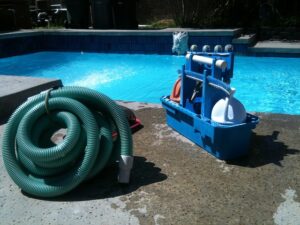A lot of my friends usually ask me how pool vacuum cleaners work. It’s simple. Pool vacuum cleaners use the suction created by the pool’s filter to remove dirt.
Knowing how a pool works is important. Pools are large bodies of water with motor pumps that circulate the water. A swimming pool also requires good circulation. It is this water that passes through the filter. The filter keeps the water free of dirt.
A pool vacuum cleaner can, surprisingly, be a lifesaver. Research has shown that a lot of harmful microorganisms found in unkempt pools can lead to fatal health hazards. But to clean the pool so well that the bacteria wouldn’t find a home, it could actually cost you about 5-6 hours or an expensive cleaning service.
However, with a pool vacuum cleaner, you can remove hazardous microorganisms, giving you time to do other things.
Forms of Pool Vacuum Cleaners
| Type of Pool Vacuum Cleaner | Description of How It Works |
|---|---|
| Manual Pool Vacuum | A manual pool vacuum typically consists of a vacuum head that attaches to a telescoping pole, a vacuum hose that connects to the skimmer or vacuum port, and a vacuum bag or canister to collect debris. The user moves the vacuum head around the pool floor and walls, using the pole to guide it. As the vacuum head moves over debris, it sucks it up through the vacuum hose and into the bag or canister. |
| Automatic Pool Vacuum | An automatic pool vacuum typically operates on a pre-set schedule, and uses a combination of suction and propulsion to move around the pool. It consists of a main unit that houses the motor and suction system, a hose that connects to the skimmer or vacuum port, and various attachments such as brushes and wheels to aid in movement. As the vacuum moves around the pool, it uses suction to pick up debris and sends it through the hose and into the pool’s filtration system. |
| Robotic Pool Vacuum | A robotic pool vacuum is a self-contained unit that uses its own motor and filtration system to clean the pool. It typically operates on a pre-set schedule and moves around the pool using wheels or tracks. As it moves, it uses brushes and suction to pick up debris and sends it into a filter bag or canister contained within the unit. Some models may also include additional features such as remote control operation, programmable settings, and advanced filtration systems. |
A swimming pool without its vacuum isn’t a health-friendly pool. You need a vacuum not only to reduce your stress but to catch dirt and clean out debris. There are two kinds of pool vacuum cleaners:
- The manual
- The automatic
- Manual Pool Vacuum

How does a manual pool vacuum work
Keeping your pool clean is essential for a healthy and enjoyable swimming experience. While there are various pool cleaning options available in the market, manual pool vacuums are often the most cost-effective and efficient solution. Essentially, it’s like using a regular vacuum cleaner, but this time, you’re using water instead of electricity.
The vacuum head is attached to a telescopic pole, which is connected to a skimmer via a long hose. As you move the vacuum head over the pool floor, it creates suction that pulls dirt and debris into the skimmer basket, where it gets trapped.
In addition to manual vacuums, there are also more advanced automatic pool cleaners on the market. These use pressurized water jets to create suction, allowing them to move around the pool floor and pick up debris with greater efficiency than manually operated vacuums. While they may cost more upfront, these powerful cleaners often require less maintenance over time and can save you precious time when it comes to keeping your pool sparkling clean.
A manual vacuum is an excellent choice if your pool is dirty, either because you recently relocated or because you haven’t used it in a long time. Other vacuum cleaners aren’t built to clean a filthy pool.
If you want a thorough cleaning, the manual pool vacuum is the right option. However, while using it, you’ll have to empty the tank periodically.
How to vacuum a pool manually
While automatic pool cleaners are an option, manual vacuuming remains the most efficient method of maintaining a sparkling pool. First, you’ll need to assemble the manual vacuum kit, which includes a vacuum head, telescopic pole, and hoses with clamps. Next, start by filling the hoses with water and attaching them to the vacuum head.
Then, insert the pole into the head and tighten the clamps. Once you’ve lowered the vacuum head into the water, connect the pole to the skimmer and move it around the pool’s bottom in a pattern that covers every inch of the surface.
Finally, remove the vacuum head and empty the collected debris into a filter or skimmer. With this step-by-step guide, you can ensure a pristine pool that’s perfect for all your aquatic activities.
Automatic Pool Vacuum
Automatic vacuums are self-cleaning equipment that cleans the pool and floor using electricity. You might use it if you have been questioning yourself about how pool vacuum cleaners work. An automatic pool vacuum is similar to a manual pool vacuum cleaner, with the exception that it requires less manual effort.
Automatic pool vacuums should always be handled with maximum care, especially when you consider the high cost of repair. Automatic vacuum cleaners come in a variety of shapes and sizes.
- Suction-side cleaners
- “Pressure side vacuums”
- Robotic cleaners
Suction-side cleaners are:
- budget-friendly
- fit for large debris cleaning.
- Easily accumulated debris
Examples of suction side cleaners include; Kreepy Krauly Kruiser, Hayward Pool Vac XL, and others.
“Pressure side vacuums”
- It needs water pressure to work.
- Fit for moderate debris cleaning.
- Inefficient with a very dirty pool
Examples of pressure-side vacuums include; Polaris Vac-Sweep 280, Zodiac F5B, and others.
Robotic cleaners
- It works with electricity.
- Fit for minute debris
- Inefficient with large debris.
Examples of robotic cleaners include; Dolphin DX4 Robotic Pool Cleaner, Sports Robotic In-ground Cleaner and others
What is the benefit of a pool vacuum?

Jumping into a sparkling clean pool is one of life’s greatest pleasures. But maintaining a crystal-clear pool requires effort and time. That’s where a pool vacuum comes in. With its powerful suction and advanced features, it helps to remove debris from the surface and bottom of the pool, ensuring a swim-ready environment.
Not only does it make your pool look inviting, but it also helps to keep the water safe and healthy for you and your family. Say goodbye to messy and inefficient manual cleaning methods and enjoy more time relaxing poolside with a pool vacuum. With its easy-to-use design and powerful functionality, it’s the perfect addition to any pool.
In addition to cleaning your pool, a pool vacuum also helps to save time and money. Because of its energy-efficient design and low maintenance requirements, you’ll be able to cut down on expensive service fees while keeping your pool clean year-round. It’s an excellent investment that will give you years of enjoyment with minimal effort. So why not invest in a pool vacuum today? You’ll be glad you did!
How to use a pool vacuum hose

Keep your pool looking crystal clear all summer with the help of a pool vacuum hose! First things first, identify where the vacuum port is on your pool. Next, attach the hose to the vacuum head and lower it into the pool – be sure to eliminate any air pockets that could hinder suction.
Connect the other end to the vacuum port and turn on the filtration system. Slowly move the vacuum head along the bottom of the pool, focusing on any areas with debris buildup. When you’re finished, turn off the filtration system and detach the vacuum hose from the pool.
Simple as that! With regular use, your pool will stay sparkling clean and ready for fun in the sun.
When vacuuming a pool what setting should the filter be on
Are you taking the plunge and vacuuming your pool? Congratulations on taking care of your backyard oasis! One question you may have is, “what setting should the filter be on?” The answer is simple – make sure that your pool’s filter is set to “Waste” or “Backwash.”
This will ensure that any debris you vacuum up goes straight out of your pool, rather than clogging up your filter. Don’t forget to set your pool’s pump to ‘filter mode’ once you’re done vacuuming. Happy swimming!
How long does it take a pool vacuum to clean a pool?
If you’re looking to keep your pool sparkling clean, a pool vacuum is an essential tool. But how long does it typically take to clean an average-sized pool? Well, the answer depends on a number of factors, such as the size of the pool, the type of vacuum you’re using, and how dirty the pool is, to begin with. On average, a pool vacuum can take anywhere from 1-4 hours to clean an average-sized pool.
It’s important to remember that the process may take longer if you haven’t cleaned your pool in a while or if there’s a significant amount of debris to remove. However, with a little bit of patience and persistence, you’ll be able to enjoy a crystal-clear pool in no time at all!
Pool Vacuum Maintenance
Both the pool and the vacuum need proper maintenance. If one of them isn’t properly taken care of, the other will suffer the consequences. If you want your vacuum to work well,
- Do not leave it in the pool.
- Don’t let it work ceaselessly.
- What does a typical pool vacuum contain?
- An electrical power supply
- Transformer
- internal filtration system.
How do pool vacuum cleaners work?
Manual vacuums take long hours to carry out their tasks. But you can be certain that an automated vacuum can run between an hour and five. Despite this dexterity, the automatic vacuum must not work ceaselessly in order to prevent wear and tear.
All automatic pool cleaners are powered by powerful electric motors that provide suction while also providing enough force to move them. It works in the same way as a home vacuum cleaner, sucking up rubbish from the pool and storing it inside the unit.
Although automatic pool cleaners are expensive compared to their manual counterparts, they average 180 watts. Compare this to common booster pump-powered hydraulic cleaners, which require over 1 kWh, i.e., 1,000 Watts! minimum The difference is 820 watts or 82% less energy consumption!
Final Thoughts
Vacuuming your pool manually is an important part of keeping the water clean, healthy, and safe to use. Not only will it keep the pool looking crisp and inviting, but it’s also essential for maintaining a healthy filtration system. By learning how to properly vacuum a pool by hand or with a hose, one can save money that would otherwise be spent on costly repairs.
Though it typically takes around three hours to effectively vacuum a large outdoor swimming pool, this time investment can end up saving you much more in the long run. All in all, manual vacuuming is the tried-and-true way to keep your swimming pool sparkling year-round!
In our modern world, everybody has a question. The answers to this question have helped to reduce our worries. In this article, we have shown you the answer to your question: how do pool vacuum cleaners work?
We didn’t stop there; we gave you some maintenance tips and best practices. And if you were extra curious, you also know the basics of a pool vacuum.














